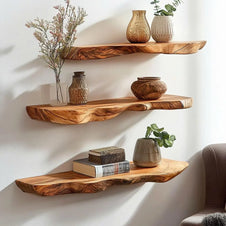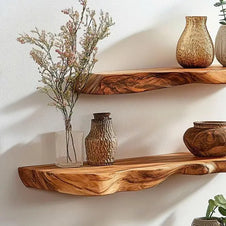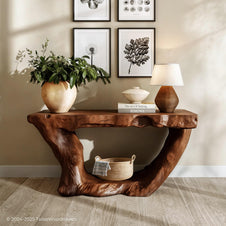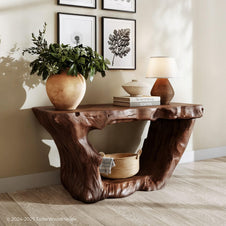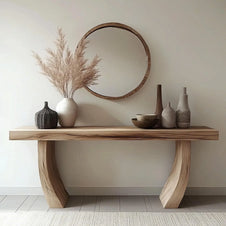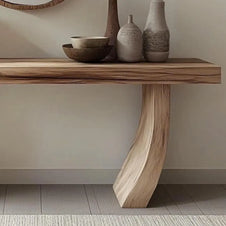Beyond its tree-like form, a tree bookshelf carries the breath of the forest where it came from. Its uniqueness lies not only in its artistic shape but also in the materials used. That’s why different tree bookshelf materials play a key role in shaping the identity, texture, and spirit of each piece.
Why Materials Matter When Choosing a Tree Bookshelf?
With its intricate, nature-inspired design, different tree bookshelf materials play a vital role in determining the structure and scale of each shelf. These materials must be sturdy enough to support books, decor items, or personal belongings while maintaining their aesthetic form.
To qualify as a high-quality piece, the materials must meet key standards:
-
Built to withstand everyday use and remain reliable over time
-
Blends seamlessly with various décor themes and design aesthetics
-
Ease of installation (especially for non-professionals)
-
Reasonable pricing within your budget

This wooden tree-shaped book stand - a compact design made from quality wood, ideal for open books or rotating featured reads in the kitchen or study corner.
It’s a great example of how the smart use of different tree bookshelf materials can deliver both visual charm and everyday functionality. Moreover, understanding popular bookshelf materials helps you avoid common mistakes when shopping or planning a DIY project.
Common Materials Used in Tree Bookshelves
Below is a quick comparison chart of the five most commonly used wood materials in today’s tree bookshelf designs:
Table 1: Quick Comparison of Popular Materials
|
Material
|
Advantages
|
Disadvantages
|
Best For
|
|
Solid Wood
|
Rich wood textures that offer both resilience and visual elegance
|
Bulky and high-cost; may require professional help for mounting
|
Homeowners, décor enthusiasts
|
|
Engineered Wood (MDF)
|
Compact and budget-friendly, perfect for a hassle-free setup
|
Prone to damage from moisture or impact
|
Students, renters
|
|
Plywood
|
Sturdy, lighter than solid wood, and cost-effective
|
Less elegant, uneven wood grain
|
Homes with kids, DIY-friendly households
|
|
Recycled/Composite Wood
|
Eco-friendly, termite-resistant
|
Less durable than solid wood
|
Green living advocates
|
|
Metal-Wood Combo
|
Modern look, highly durable
|
Complex to install, often pricey
|
Office spaces, loft apartments
|
Materials vary widely in price and design, making them accessible across different budget levels. However, relying solely on surface-level pros and cons won’t help you make the best decision. What matters most is understanding the different tree bookshelf materials at their core and how they serve your specific usage goals.
Pros and Cons of Each Material
-
Solid Wood – Elegant, Strong, and Long-Lasting
Natural wood types like oak, pine, or mahogany offer unmatched beauty and durability. When well-maintained, they can last for decades. Some oak tree bookshelves even become heirloom pieces passed down through generations.

A handcrafted wall-mounted shelf, designed in rustic tree form is perfect for boho or nature-inspired interiors.
Advantages:
-
Natural scent, safe for indoor health
-
Strong structural integrity, capable of holding heavier items
-
Perfect complement to minimalist, nature-inspired interiors

Crafted from birch, this tree bookshelf enhances serene Scandinavian-inspired corners with natural warmth.
Disadvantages:
-
Heavier weight; challenging to mount on weaker walls
-
Can warp if untreated or exposed to humidity
-
Higher cost compared to other tree bookshelf materials
-
Engineered Wood (MDF, HDF) - Affordable and Accessible
Engineered wood is one of the most common different tree bookshelf materials, especially in ready-made or mass-produced shelves sold online and in furniture chains. Made by compressing wood fibers and resin under high pressure, it offers a smooth finish, is easy to work with, and is lightweight, making it a go-to choice for renters or students.
Advantages:
-
Budget-friendly and easy to assemble
-
Available in various finishes and colors, from matte white to woodgrain textures
-
Compatible with adhesive or no-drill wall mounts for minimal damage
Disadvantages:
-
Less durable than natural wood, especially under heavy loads
-
Prone to swelling or peeling when exposed to high humidity or direct moisture
-
Not ideal for long-term or heirloom furniture
Still, for anyone seeking accessible and stylish options, engineered wood remains one of the most practical different tree bookshelf materials, especially for short-term living or low-traffic areas.
-
Plywood: The DIY-Friendly Choice
Plywood is made by layering thin wood veneers, resulting in a strong, flexible, and relatively lightweight sheet. At Tailor Wood Haven, it’s considered one of the best different tree bookshelf materials for DIYers thanks to its versatility, cost-effectiveness, and reliable strength.
Advantages:
-
Easy to cut into branch-like or asymmetrical shapes, ideal for creative bookshelf designs
-
Stable surface with low risk of warping, even over time
-
Works well with paint, stains, or clear coats for customization
Plywood bridges the gap between quality and affordability. For those who love building or customizing furniture, it’s one of the most rewarding and forgiving different tree bookshelf materials available today.
However, it still comes with certain limitations that you should take into consideration.
Disadvantages:
-
Requires painting or sealing for a finished look
-
Exposed edges may chip or fray if not sanded or handled carefully
-
Moderately priced compared to budget materials, offering better value
Among all the different tree bookshelf materials available, plywood stands out as a smart middle ground between beauty, durability, and cost are making it ideal for creative at-home builds.
Different Tree Bookshelf for Different Demands
Now that we’ve explored the nature of each wood type, the next question is: Which material suits which purpose best? To help you visualize, here’s a table suggesting materials based on specific needs:
Table 2: Recommended Materials by Use Case
|
Use Case
|
Suggested Material
|
|
Bookshelf in a child’s room
|
Plywood or engineered wood with rounded, child-safe edges
|
|
Small spaces (studio, rentals)
|
MDF or HDF – lightweight and easy to relocate
|
|
High durability required
|
Solid wood or quality composite wood
|
|
At-home DIY projects
|
Plywood – flexible and easy to shape
|
|
Rustic, Japanese, or Nordic style
|
Pine or oak
|
|
Easy installation (no drilling)
|
Lightweight floating shelves in plywood or MDF
|
These recommendations show how different tree bookshelf materials respond uniquely to lifestyle demands. If you're furnishing a rental apartment or decorating a nursery, going for lightweight or pre-treated plywood will minimize risk and effort.
Meanwhile, for those prioritizing aesthetic and longevity, solid oak or pine fits better. Understanding how different tree bookshelf materials function in context can save both time and money to help you build a space that’s both personal and practical.
Avoid Common Mistakes When Choosing Different Tree Bookshelf Materials
When selecting different tree bookshelf materials, steer clear of these frequent errors:
-
Choosing wood that’s too heavy for weak or thin walls → can cause structural damage or even collapse over time.
-
Skipping moisture protection → MDF and other engineered woods can swell, warp, or delaminate when exposed to humidity, especially near windows, kitchens, or bathrooms.
-
Using the wrong screws or anchors for your wood type → weakens support, leading to sagging or shelf detachment after a few months of use.
-
Choosing painted wood with lead or formaldehyde → is highly hazardous in spaces like children’s rooms, where air quality and safety are priorities.
Commentary: Even the most beautiful tree bookshelf design can fail if the wrong material is used in the wrong context. Materials should be selected based not just on looks, but also on where the shelf will be placed, how much weight it will bear, and who will interact with it. That’s why understanding different tree bookshelf materials goes hand in hand with knowing where and how your shelf will live.
Think beyond aesthetics and consider practicality, safety, and longevity. Whether you’re installing in a humid bathroom, a child’s playroom, or a minimalist apartment, matching the material to the environment ensures the shelf’s function and safety last for years. A thoughtful balance of design and material choice makes all the difference.
Offbeat Tree Shelf Ideas
If you enjoy experimenting and saving money, here are a few creative ways to build a tree bookshelf from surprising materials, while still embracing the charm of different tree bookshelf materials:
-
Dried real tree branches: Use a sturdy, well-dried branch as the central spine, then attach lightweight trays made from rattan, bamboo, or acrylic. This adds a poetic, nature-inspired element to your wall.
-
Old pallets: Disassemble and reuse the wooden planks to build shelves with character and texture. It’s a low-cost, sustainable way to bring rustic charm into your space.
-
PVC pipes or thin metal frames: Combine them with stained plywood boards for a sleek, modern industrial aesthetic that feels both urban and handmade.
Note: When using reclaimed or recycled materials, always sand down sharp edges and seal all surfaces with a non-toxic finish. This prevents splinters and makes your shelf safe for indoor use.
Exploring different tree bookshelf materials from non-traditional sources isn’t just fun, it’s also a way to reduce waste, personalize your space, and create a functional art piece with a story. Best of all, it proves that creative bookshelf solutions don’t need to come from a store but just from your imagination and a few weekend hours.
Conclusion: Material Is the Soul of Every Tree Bookshelf
Whether you plan to purchase or build your tree bookshelf, understanding and selecting correctly the different tree bookshelf materials is key to crafting a piece that’s not only beautiful and durable but also safe and meaningful.
Start by identifying your needs: Do you prefer something lightweight and easy to install, or are you seeking a striking centerpiece to express your artistic taste? Does your living space prioritize convenience or style?
Once your priorities are clear, choosing between natural wood, engineered wood, plywood, or recycled materials becomes much more straightforward. And remember: a beautiful tree bookshelf always begins with a smart, intentional choice of material.

A statement piece for cozy and earthy homes - this solid wood tree trunk bookcase is proof that the right material creates a timeless impact.
Summarily, if you're looking for more inspiration on designing and building bookshelves with various materials, stay tuned for our upcoming articles on DIY bookshelves, Scandinavian-inspired decor, and eco-friendly wood applications in interior design — your next creative idea might just be one read away.

